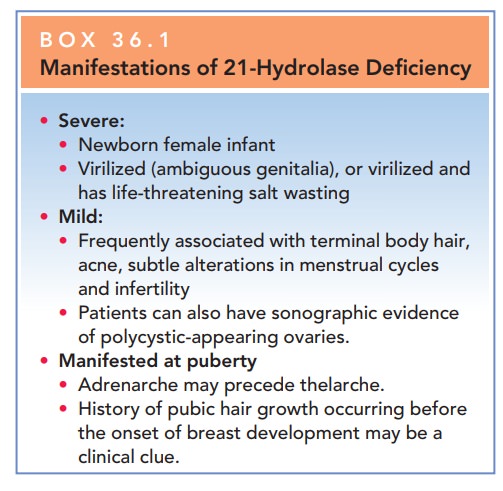Chapter: Obstetrics and Gynecology: Hirsutism and Virilization
Adrenal Androgen Excess Disorders
ADRENAL ANDROGEN EXCESS DISORDERS
Adrenal disorders that cause an
increase in androgen pro-duction can lead to hirsutism and virilization; the
most common are congenital adrenal hyperplasia, Cushing syn-drome, and adrenal
neoplasms.
Congenital Adrenal Hyperplasia
Congenital
adrenal hyperplasia (CAH) is caused byenzyme
deficiencies that result in precursor (substrate) excess, thus resulting in
androgen excess. DHEA is a pre-cursor for androstenedione and testosterone.
The most
common cause of increased adrenal androgen pro-duction is adrenal hyperplasia
as a result of 21-hydroxylasedeficiency;
21-hydroxylase catalyzes the conversion of pro-gesterone and 17α-hydroxyprogesterone
to desoxycortico-sterone and compound S.
When 21-hydroxylase is deficient,
there is an accumu-lation of progesterone and 17α-hydroxyprogesterone, which are
metabolized subsequently to DHEA. This dis-order affects approximately 2% of the
population and is caused by an alteration in the genes for 21-hydroxylase,
which are carried on chromosome 6. The genetic defect is autosomal recessive
and has variable penetrance.
In the
most severe form of 21-hydroxylase
deficiency, the newly born female infant is simply virilized (ambiguous
geni-talia) or is virilized and suffers from life-threatening salt wast-ing
(Box 36.1). However, milder forms are more commonand can appear
at puberty or even later in adult life. A mild deficiency of 21-hydroxylase is
frequently associated with terminal body hair, acne, subtle alterations in
menstrual cycles, and infertility.
Box 36.1
Manifestations of 21-Hydrolase Deficiency
Severe:
·
Newborn
female infant
·
Virilized
(ambiguous genitalia), or virilized and has life-threatening salt wasting
Mild:
·
Frequently
associated with terminal body hair, acne, subtle alterations in menstrual
cycles and infertility
·
Patients
can also have sonographic evidence of polycystic-appearing ovaries.
Manifested at puberty
·
Adrenarche
may precede thelarche.
·
History
of pubic hair growth occurring before the onset of breast development may be a
clinical clue.
These patients can also have
sono-graphic evidence of polycystic-appearing ovaries. When21-hydroxylase deficiency is manifested at puberty, adrenarche may
precede thelarche. The history of pubic hair growthoccurring before the
onset of breast development may be a clinical clue to this disorder. The
diagnosis of 21-hydroxylase deficiency is made by measuring increased 17-OH
progesterone in plasma during the follicular phase (preferably measured while
fasting). Patients with classic 21-hydroxylase deficiency will have
significantly elevated plasma 17-OH progesterone levels, usually over 2000
ng/dL. Those with less severe 21-hydroxylase deficiency may have mildly
elevated basal levels, 200 ng/dL, and an increase to usually 1000 ng/dL in
response to ACTH stimulation. Dehydroepiandrosterone sulfate (DHEA-S) and
androstenedione will also be elevated and contribute to the hirsutism and
virilizing signs.
A less-common
cause of adrenal hyperplasia is 11β-hydroxylase
deficiency. The enzyme 11β-hydroxylase catalyzesthe
conversion of desoxycorticosterone to cortisol. A defi-ciency in this enzyme
also results in increased androgen production. The clinical features of 11β-hydroxylase defi-ciency are mild
hypertension and mild hirsutism. The diagnosis of 11β-hydroxylase deficiency is made
by dem-onstrating increased plasma desoxycorticosterone.
Treatment of CAH is aimed at
restoring normal corti-sol levels. In CAH, cortisol production is reduced
secondary to enzymatic block. This decreased cortisol production results in a
compensatory increase in ACTH secretion to attempt to stimulate cortisol
production. This increased ACTH production results in the oversecretion of
precur-sor molecules proximal to the enzymatic block, which results in
oversecretion of androgens. In patients with a high-grade enzymatic block,
inadequate amounts of glu-cocorticoids and mineralocorticoids are made,
resulting in salt loss, which can be life-threatening. Nonclassic CAH canbe managed easily by supplementing glucocorticoids. Usually,prednisone,
2.5 mg daily (or its equivalent), suppresses adrenal androgen production to
within the normal range. When this therapy is instituted, facial acne usually
clears promptly, ovulation is restored, and there is no new termi-nal hair
growth.
Medical
therapy for adrenal and ovarian disorders cannot resolve hirsutism. It can
only suppress new hair growth. Hairthat is present must be controlled by shaving,
bleaching, using depilatory agents, by electrolysis or laser hair ablation.
Cushing Syndrome
Cushing syndrome is an adrenal disease resulting
in adrenalexcess. As a result of an adrenal
neoplasm or an ACTH-producing tumor, the patient demonstrates signs of
corti-costeroid excess that include truncal obesity, moonlike facies, glucose
intolerance, skin thinning with striae, osteo-porosis, proximal muscle weakness
in addition to evidence of hyperandrogenism, and menstrual irregularities.
Adrenal Neoplasms
Androgen-secreting adrenal
adenomas cause a rapid in-crease in hair growth associated with severe acne,
amenor-rhea, and sometimes virilization. In androgen-secreting adenomas, DHEA-S
is usually elevated above 6 mg/mL. The diagnosis of this rare tumor is
established by computed axial tomography (CAT) or magnetic resonance imaging
(MRI) of the adrenal glands. Adrenal adenomas must be removed surgically.

Related Topics